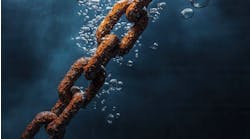Developing sour grade linepipe for challenging environments
Simon Slater
Tata Steel
As the oil and gas industry develops ever-more challenging reserves, technologies have to adapt and evolve to cope with these more aggressive, corrosive environments characterized by high pressures and high temperatures.
Tata Steel specializes in material for tough offshore and onshore plays, with each development bringing a new set of testing considerations in terms of pipe manufacture and installation – spurring the sector on to look at higher strength materials.
Offshore material generally is optimized at strength level API X65 for a balance of strength, toughness, and ductility as well as corrosion resistance.
Tata has completed preparations for the shift to X70 linepipe that will build upon the success of X65.
X70 is essentially stronger than X65, and needs to maintain the same resistance to corrosion to protect it from extreme conditions. Research and development by Tata Steel and its plate-manufacturing partners addresses this issue from the in steel making and pipe forming end.
Manufacture of plate material
The result was six trial heats, with increased manganese content in order to raise the strength of the material up to X70, while still satisfying the project specifications for X65.
Battelle drop-weight-tear tests (BDWTT) were undertaken at a temperature of -10°C (14°F) to evaluate the material’s resistance to fracture. With the exception of a single result at 95%, all achieved a 100% shear area. Charpy impact testing was also performed to determine energy absorbed at -40°C (-40°F) producing no value less than 450 J.
Hydrogen induced cracking (HIC) testing produced no cracking on the three heats tested.
Manufacture of pipe material
Through pipe forming the properties of the plate are transformed. The chemical composition and rolling parameters of the mother plate as it is plastically deformed can affect the work hardening of the plate. This is one factor that determines the finished shape of the pipe and optimises the performance of the mill, as plate formability influences productivity. Furthermore, the high levels of strain induced on the plate material as it is formed may reduce the final toughness of the pipe and also reduce its resistance to cracking in the presence of sour hydrocarbons.
The plates produced to achieve X70 properties were formed into pipes at Tata’s Hartlepool, UK, facility using the UOE process. During this process, pipes move through three pressing stages to form the pipe prior to SAW welding. This involves the flat plate been curved to form a “U” shape, it is then squeezed further to make an “O” shape, before being welded along the seam. The final pipe then is expanded to the desired size and straightness.
Ten pipes were witnessed through the “O” press and dimensional measurements were made immediately afterwards along with two control pipes either side to establish if there were any difference in the forming characteristics of the individual plates.
Material Properties
Once formed, the plates created a pipe with an outside diameter of 711 mm (28 in) and a wall thickness of 19.1 mm (0.75 in). When observed through the pressing line, 10 of the X70 trial pipes demonstrated a greater degree of peaking (pipes average from 1.6 mm-1.72 mm (0.063-0.067 in), greatest value 1.8 mm (0.07 in) than the pipes immediately preceding and following (pipe average from 1.59 mm-1.57 mm (0.0625-0.0618 in), greatest value 1.6 mm(0.063 in).
Manufactured pipe on its way offshore.
Although not a significant change, this was expected as the plates have a higher strength and behave differently during “C” and “O” pressing, this demonstrates the need to optimize the mill tooling for the specific incoming plate material.
At final inspection, after expansion of the X70 trial pipes, the average peaked at 0.53 mm (0.02 in) over a range from 0.2 mm-1 mm (0.0078-0.039 in), with an overall average of 0.46 mm (0.018 in). Working with a maximum acceptance criteria of 1.6 mm demonstrated that even with the higher alloyed steel, shape of the pipes were controlled and maintained through the pipe forming process to very high level of accuracy.
During the tensile testing phase, material met the required strength of 483 MPa in pipe form, clearly showing that it can be categorized as a material suitable to be classed as X70.
Impact resistance
Charpy impact testing showed remarkable similarities between the X70 and the standard X65 linepipe. In addition to meeting the pipe body and weld requirements, the X70 also met the fusion line impact requirements. The increase in manganese for strength purposes also had no detrimental effect on toughness.
Battelle drop weight tear tests were performed at 0°C (32°F), -30°C (-22°F), and -40°C to construct the Battelle transition curves. This is an important linepipe property for gas lines as it demonstrates the temperature at which the pipe may be susceptible to brittle catastrophic failure.
Should gas begin to escape from a linepipe, it will then chill the surrounding material as it expands (similar to a fire extinguisher or aerosol). It is therefore important to know at what temperature the material exhibits brittle fracture, and ensure that the design temperature is above this value.
The Battelle transition curves indicate an 85% fracture appearance transition temperature (FATT) between -30°C and -40°C, which is suitable to meet even the most onerous BDWTT pipeline requirements.
Sour service
The pipes then were tested for sour corrosion resistance. Once corrosion of the steel commences, free hydrogen ions can propagate through the steel matrix and gather at small discontinuities in the steel.
As more hydrogen diffuses to these locations, the localized pressure increases, which can cause cracks to form. Resistance to this form of cracking generally is achieved by reducing the presence in the steel, by preventing; inclusion formation, modifying the shape of any inclusions, reducing the level of segregation, and reducing hardness. For higher strength X70 linepipe the increased presence of alloying elements, in this case manganese, can greatly reduce the resistance to sour cracking.
Testing of the X70 material showed the plate and pipe both retained resistance to corrosion cracking.
Even after pipe making, no cracks were observed in any of the material, illustrating its performance for sour service applications.
Offshore Articles Archives
View Oil and Gas Articles on PennEnergy.com





